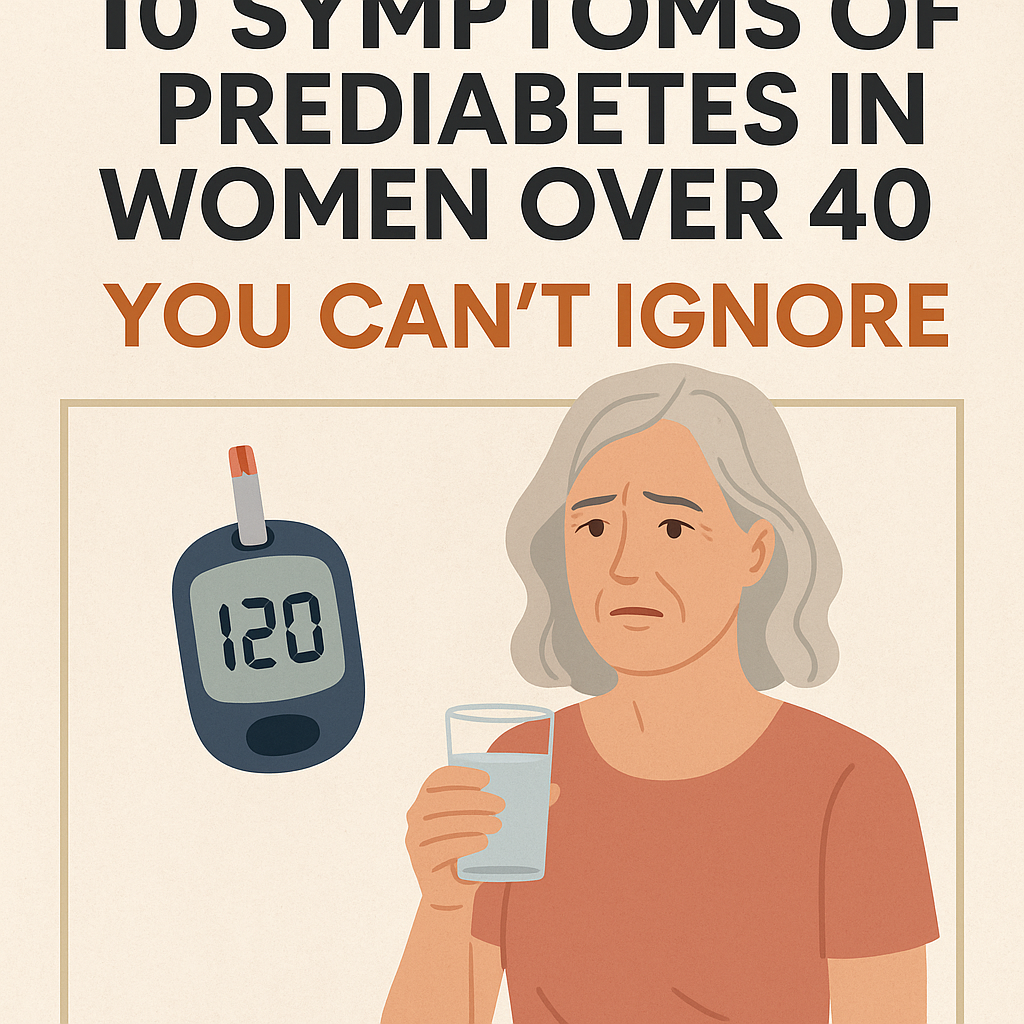
⚠️ Affiliate Disclaimer: This post may contain affiliate links, which means I may earn a small commission — at no extra cost to you — if you make a purchase through one of these links. I only recommend products or services I genuinely trust and believe can provide value. Thank you for supporting My Medical Muse!
10 Symptoms of Prediabetes in Women Over 40 You Can’t Ignore
Symptoms of Prediabetes in Women Over 40 That You Shouldn’t Ignore
Table of Contents:
2. Why Women Over 40 Are More at Risk
3. Early Warning Signs of Prediabetes
4. Moderate Warning Signs That Need Attention
5. Advanced Warning Signs You Shouldn’t Ignore
6. Hidden and Overlooked Symptoms in Women Over 40
7. How to Check Your Blood Sugar at Home
9. Lifestyle Changes to Reverse Prediabetes
What Is Prediabetes?
Prediabetes is a metabolic condition where your blood sugar levels are higher than normal but not high enough to be classified as type 2 diabetes. For many women, it develops silently over years, often going unnoticed until routine blood work reveals it.
Blood sugar ranges that indicate prediabetes:
- Fasting blood sugar: 100-125 mg/dL (5.6-6.9 mmol/L)
- Oral glucose tolerance test (2 hours after eating): 140-199 mg/dL (7.8-11.0 mmol/L)
- HbA1c: 5.7%-6.4%
- Also Read: Everything You Need To Know About Diabetes.
Why Women Over 40 Are More at Risk
Once you hit your 40s, hormonal shifts, metabolism slowdown, and lifestyle changes make your body less efficient at processing sugar.
Key risk factors for women over 40:
- Perimenopause and menopause: Falling estrogen levels can lead to insulin resistance.
- Slower metabolism: Fewer calories burned means more unused glucose.
- Increased visceral fat: Fat around the waist increases inflammation and insulin resistance.
- Family history: Genetics plays a strong role.
- History of gestational diabetes: Increases lifetime risk of type 2 diabetes by 50%.
Early Warning Signs of Prediabetes
These are often mild, vague, and easy to dismiss, but catching them early can prevent full-blown diabetes.
1 .Fatigue That Doesn’t Go Away:
When your cells can’t use sugar properly for energy, you may feel tired all the time even after sleeping well. Keep a blood glucose monitor handy (Shop on Amazon) to track your sugar when fatigue hits.
2. Increased Thirst (Polydipsia):
You may feel like you can’t quench your thirst, especially after meals. This happens because your body pulls water from tissues to dilute excess sugar in your blood.
3. Frequent Urination (Polyuria):
The kidneys work overtime to flush out excess sugar, leading to more bathroom visits, sometimes even waking you at night.
4. Unexplained Weight Gain or Difficulty Losing Weight:
Insulin resistance can cause your body to store fat more easily, especially around the midsection.
5. Sugar Cravings and Increased Appetite:
Fluctuating blood sugar can cause intense hunger shortly after eating, especially craving sweets or carbs.
Moderate Warning Signs That Need Attention
If prediabetes progresses without intervention, these more noticeable symptoms may appear.
1. Blurred Vision: High blood sugar draws fluid into your eyes, temporarily changing their shape and affecting focus.
2. Slow Healing of Cuts and Wounds: Excess glucose slows blood flow and weakens immune response, making even small cuts take longer to heal.
3. Tingling or Numbness in Hands and Feet:
Nerve damage (diabetic neuropathy) can start even in prediabetes, leading to mild pins-and-needles sensations.
4.4 Skin Changes (Acanthosis Nigricans):
Look for dark, velvety patches around the neck, armpits, or groin, a common sign of insulin resistance.
5. Frequent Yeast Infections or UTIs: High blood sugar creates an ideal environment for fungal and bacterial overgrowth.
Advanced Warning Signs You Shouldn’t Ignore
If prediabetes remains uncontrolled, your symptoms may start to resemble early diabetes.
1. Significant Unintentional Weight Loss: When your body can’t use sugar, it starts burning fat and muscle for energy.
2. Severe Fatigue and Brain Fog: Glucose swings can cause mental confusion, forgetfulness, and lack of focus.
3. Vision Problems Worsening Quickly: Persistent blurred vision, floaters, or vision loss require urgent medical attention.
Hidden and Overlooked Symptoms in Women Over 40
Some symptoms are often attributed to aging or menopause but may actually be linked to blood sugar issues:
- Mood swings or irritability after meals
- Dry, itchy skin
- Hair thinning
- Frequent headaches
- Unexplained skin rashes
How to Check Your Blood Sugar at Home
You don’t need to wait for your next doctor’s visit. Two ways to monitor:
- Finger-prick glucometer: affordable and accurate. (See top-rated option on Amazon)
- Continuous Glucose Monitor (CGM): wearable device that tracks your sugar 24/7. Many readers find CGMs helpful for spotting patterns in food and lifestyle.
When to See a Doctor
Make an appointment if you have:
- Two or more symptoms listed above
- A family history of diabetes
- BMI over 25 (or over 23 if Asian descent)
- History of gestational diabetes or PCOS
Lifestyle Changes to Reverse Prediabetes
Prediabetes is reversible with the right steps.
- Improve Your Diet: Choose low-glycemic foods like whole grains, legumes, and leafy greens. Limit sugary drinks and refined carbs, include high-fiber foods to slow glucose absorption.
- Exercise Regularly: Aim for 150 minutes of moderate activity weekly brisk walking, cycling, or swimming.
- Manage Stress: Chronic stress raises cortisol, which can spike blood sugar. Try yoga, meditation, or breathing exercises.
- Prioritize Sleep: Poor sleep affects insulin sensitivity. Aim for 7-9 hours nightly.
- Monitor Your Blood Sugar: Track your readings to see how food, exercise, and stress affect you.
👩⚕️ Need Personalized Health Advice?
Get expert guidance tailored to your unique health concerns through MuseCare Consult. Our licensed doctors are here to help you understand your symptoms, medications, and lab results—confidentially and affordably.
👉 Book a MuseCare Consult Now

